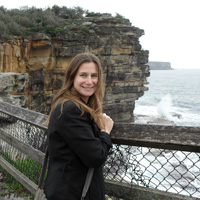 Recycled Groundwater Development at Harmony Grove, San Diego County, CACheryl Johnson Friday, December 14th, 2012 |
| ABSTRACT The Harmony Grove Valley, located in an unincorporated area of northern San Diego County, California, is being considered as a location for underground storage, extraction, and re-use of treated, recycled water. Treated recycled water would be pumped, or allowed to infiltrate into the high point of this small fractured bedrock groundwater basin, and extracted at a lower point. A screening-level groundwater model was developed using MODFLOW and Groundwater Vistas to assess the amount of water that can be stored and extracted annually, and the residency time of the recycled water underground. The model was based on researched aquifer parameters, including those from local weathered hard rock aquifers, site specific well logs to characterize the subsurface, and was calibrated against hydraulic head data from wells in the study area. Subsurface geology was generalized for the model as a 100 foot thick layer of regolith overlying unweathered fractured bedrock. Four injection wells and four extraction wells were modeled at distances ranging between 5,000 and 7,500 feet apart for the near and far wells, and the flow rates and durations were varied to obtain the maximum amount of flow without flooding injection wells or drying out pumping wells. Injection and pumping wells were screened only through the regolith, such that flow of the injected and extracted water is assumed to occur within this connected media rather than the fractured bedrock, which is less predictable in terms of travel time. Modeled maximum injection and pumping volumes generated less than 500 acre-feet per year, which may even be an over estimate based on pumping rates sustained on site. A sensitivity analysis was also conducted, which showed that the groundwater model was sensitive to changes in hydraulic conductivity and specific yield. Retention time calculations are also sensitive to porosity. Retention time was modeled using MODPATH for a range of porosity values. Although calculated recycled groundwater retention times are not prohibitive, the low estimated annual yield of less than 500 acre-feet may make such a project economically ineffective at this location. |

